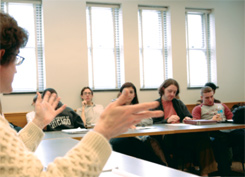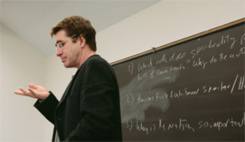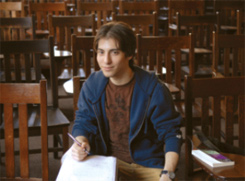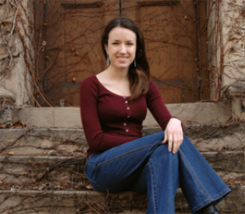Living Legacy
What does a great 21st-century general education look like? Glimpses into two Core classrooms reveal a tradition scrutinized, contested, fi ne-tuned—and strong. By Jerome Tharaud, AB’02. Photographs by Dan Dry.
Students in Bradin Cormack’s Media Aesthetics class have read Schoenberg’s ideas about composition and listened to Bessie Smith play the blues. Later in the quarter they’ll watch a Francis Ford Coppola film and read an essay by Theodor Adorno about radio.
Today, however, they’re back to basics, painstakingly reading and discussing a text. Cormack, an assistant professor in the English Department, is leading the class through a discussion of the “generic mixing” in W.E.B. Du Bois’s 1903 The Souls of Black Folk, which shifts from Reconstruction history to political polemic to autobiography in the first 50 pages.
“You have to go slowly,” Cormack tells the students. “You have to let his sentences teach you something.” The group kneads Du Bois’s arresting opening passage, teasing out the meanings of his image of the “veil” dividing the races. Cormack pauses to make sure they see how a seemingly straightforward sentence “starts to bubble.” Media Aesthetics, which first-year Katharine Bierce describes as an “atom-smasher of ideas,” is the newest Humanities sequence in the Core. Last fall when Bierce wanted advice about which Core sequences to take, older students characterized courses like Greek Thought and Literature and Human Being and Citizen as more “traditional” sequences.
“I wanted something that was challenging but different,” Bierce says. “Media Aesthetics is not just Aristotle and Plato—it’s Aristotle and Plato’s relation to modern sculpture, film, music, and art.” Bierce began fall quarter reading part of The Republic and the Poetics—along with Michel Foucault, Walter Benjamin, and other modern thinkers— and finished it with a final paper comparing Alfred Hitchcock’s Vertigo to Anish Kapoor’s bean-shaped sculpture Cloud Gate in Chicago’s Millennium Park.
The sequence is one example of how the Core has evolved to reflect a world that has changed greatly since Humanities professor Herman Sinaiko began teaching in the 1950s. “The intellectual introduction to that world has to be different than it was 50 years ago,” says Sinaiko, who still teaches Human Being and Citizen. “It is absurd that students, if they were to do an introduction to art, should never look at a Chinese landscape or an Indian sculpture or a Persian miniature. That’s a part of their world now.” Likewise, he adds, students have to grapple with globalization and environmental issues seldom thought of when he was a student.
“I think the challenge now for the University and the faculty is to think about what we would want to do in the way of a fundamental Core that would give our students an intellectual introduction to the world that they’re going to live in, which is not the 20th century world—it’s a 21stcentury world.” Courses in the biological and physical sciences have “radically changed” to keep up with changes in science, Sinaiko says, and he sees great opportunities for “thinking about the Humanities and Social Sciences in a more integrated fashion.”
So what should a 21st-century Core look like? In one sense, not much different, according to Dean of the College John Boyer. “The Core does a number of things that would have been valuable in any century,” he says. Rather than simply imparting knowledge, it teaches basic intellectual skills like “teaching students to think through demanding intellectual problems and to defend their positions with authority and conviction.” Boyer brings to the subject an unusually informed perspective; in addition to overseeing the undergraduate curriculum as dean, he became its historian when his long essay on the 1931 creation of the Core appeared in the University Record last January. The essay reveals that the design of the Core has been contested from the beginning—and that this frequently heated curricular debate has itself, as he puts it, “played a critical role in defining and sustaining the basic premises of our demanding curriculum.” Moreover, its effects are felt throughout the institution, well beyond the College; the Core, Boyer says, “has brought us these traditions of interdisciplinary collaboration— faculty from different departments teaching with each other, which is then percolated upward into graduate workshop programs and the interdisciplinary committees. I think over time these Core courses have had a very profound effect on the cultural fabric of the wider university.” Boyer believes the coming decades won’t bring radical restructuring so much as “pragmatic” changes to individual Core courses, largely driven by faculty. One example, he says, is the recent shift in the Core’s Civilization sequences toward courses taught abroad, which require foreign language instruction, reflecting the College’s recognition of a growing need to communicate with people from other cultures. “That didn’t involve changing the basic paradigm of the Civ courses so much as creatively readapting them to an exciting new context,” says Boyer, who emphasizes the need for a “manageable” curriculum that faculty are willing to teach.
“In the end, the faculty own the Core,” he says. “It’s their Core, and they have to decide what a 21st-century Core is, and I think most of them would think of it in terms of their own courses.” These decisions get hashed out in public and in private, in the staff meetings held for faculty of most Core sequences and in professors’ offices across campus. They are tested in the classrooms of classic Core sequences and hip new ones alike. Whatever their vintage, Core courses are continually under intense negotiation.
While Cormack and his students discuss Du Bois’s critique of liberal subjectivity, across the quads students engage in what many would see as a more traditional Social Sciences Core class. With the exception of the purring notebook computers and the high-tech coffee mugs on the tables, Gary Herrigel’s Power, Identity, and Resistance section seems like a class one could have taken in the Hutchins College of the 1940s. Herrigel, associate professor of Political Science and chair of the Power sequence, paces in front of the board asking questions that tease out the nuances of Rousseau’s state of nature, the relationship of desires, passions, and self-interest, and how Rousseau’s ideas relate to those of Smith, Marx, and Durkheim.
Beneath its classic façade, Power is an example of the way even the most venerable sequences never stop evolving. A sequence that began in the 1980s as a political philosophy sequence focusing on the “state of nature” changed in the 1990s to reflect a new concern with culture and politics, particularly race, gender, and sexuality, Herrigel says. Now he sees the course beginning to take up questions like the relationship of the West to non-Western cultures and the role of spirituality and religion in politics. That means introducing new readings to the syllabus—such as Gandhi, Frantz Fanon, and Karl Polanyi—as well as reading classic texts in new ways.
Every Monday morning Herrigel meets with other instructors of the course’s 18 sections in Gates-Blake 132. The meetings help them stay on the same page as they teach from a syllabus that changes from year to year. This year, for example, selections from Robespierre’s “Discourse on Terror” were added. Instructors and TAs discuss the implications: Will students assume Rousseau was responsible for the Terror? They might too easily link Hobbes and Rousseau to totalitarianism, “which makes Locke the hero,” instructor Andrew Sloin points out. Herrigel responds that Robespierre provides students a context to understand Burke, who comes next on the syllabus, but agrees it is important not to brand Marx and Hobbes “enemies to autonomy.”
Changes like this one begin each summer when Herrigel meets with Harper-Schmidt Fellows, visiting assistant professors who help plan and teach Core sequences. He and the four fellows assigned to Power review the year and talk about changes they might like to make. After another meeting with the fellows before each quarter, all the instructors meet to discuss the proposals and draw up a template syllabus.
“The course over time really reflects the training and interests of the Harper-Schmidts, and me,” Herrigel says. “I’m a force for continuity and they’re a force for change, and so there is a kind of evolution.”
When Power was created it was largely staffed by instructors from Political Science, Herrigel said, but since then it has become more diverse. The sequence’s current Harper-Schmidt Fellows include a political theorist, two anthropologists, and a historian. Recently the fellows’ interests have resulted in a more historical approach, particularly in spring quarter when students read their way through the 20th century, from the likes of Vladimir Lenin and John Dewey to contemporary thinkers like Anthony Appiah.
Naomi Beck, a Harper-Schmidt Fellow who studies the history of science, began teaching Power in the fall of 2005. After teaching the sequence for a year, she and her colleagues sat down to work. They rearranged the autumn Marx readings to help students get a better sense of his thought. They removed Nietzsche, who was a “bit of a conversation stopper” in the course’s discussion of liberalism, and added readings about nationalism by Fichte and Herder to better enable students to talk about the 20th century in the spring.
One of Beck’s biggest concerns is to make sure students see how the ideas they read in class are not floating “up there in the air,” separate from historical and political realities. “All of these ideas have already been debated in the past, and if you don’t realize that these debates are old and have a history, then you lack the basis for understanding the premises of our current debates,” she says. Beck sees enhancing the historical underpinnings of the sequence as one way to make students see the ideas’ relevance to today. Durkheim’s ideas about solidarity, for example, could provide a useful lens to think about contemporary welfare states and proposals for a public health system in the U.S., Beck muses. “These ideas are still out there—not only still out there, but they come back in new versions, so it definitely makes sense to continue discussing them,” she says. “And it’s our job to show students the relevance of the theories to contemporary life.”
Media Aesthetics has undergone similar changes. It originated in the 1980s in a Humanities sequence called Form, Problem, Event, which examined an artistic form in the fall, a philosophical problem in the winter, and a historical event in the spring, says Larry Rothfield, associate professor of English and chair of the sequence. “It was a great core, but these newfangled cores tend to have a lifecycle because they’re riding the wave of contemporary thinking,” he said. That sequence eventually “decayed in radioactive fashion” into Reading Cultures and Media Aesthetics in the 1990s, he says. While Reading Cultures focuses on the ways in which texts interact with people and cultures, Media Aesthetics has kept the emphasis on methodological distinctions it inherited from Form, Problem, Event but is now organized by artistic media rather than by discipline: visual representation in the fall, musical composition in the winter, and textual interpretation in the spring.
Students begin each quarter, Bradin Cormack says, by examining a series of short “trigger texts” ranging from Velázquez’s Las Meninas and Luciano Berio’s Sequenza III for voice to essays by Roland Barthes and W.C. Handy. They then give sustained attention to a small number of central texts before turning to a series of case studies to explore how the literature and art contribute to the philosophical conversations they’ve been engaged in. The central texts—including Du Bois’s The Souls of Black Folk, Plato’s Republic and Phaedrus, Aristotle’s Poetics, and Wilde’s Picture of Dorian Gray— have largely remained stable, but the supporting cast of works is flexible and has shifted according to faculty input, Cormack says. At a faculty meeting this year, for example, Lara Cohen, a Harper- Schmidt Fellow who studies American literature, had an idea that intrigued Cormack.
“She suggested that it might be useful to teach Emily Dickinson against Blake, and that’s what I’m doing this year. For me it’s going to be an experiment to see how that pairing works,” he says. Like Power instructor Naomi Beck, Rothfield believes his sequence should be useful to students outside the classroom. “It helps them to be more canny—better able to grasp what’s being done with them and to them by the media in which they’re immersed. I’m not sure it makes them better human beings or citizens,” Rothfield says, “but we like to think so.” At the very least, he adds, it makes them “better voyagers through the mediascape.” Many undergraduates still come to the University of Chicago specifically for the Core, Boyer says, and more traditional Humanities and Social Sciences sequences still draw the most students. The three “classic” Social Sciences sequences— Power, Identity, and Resistance; Classics in Social and Political Thought; and Self, Culture, and Society—are still by far the most popular with undergraduates, says Constantin Fasolt, Master of the Social Sciences Collegiate Division. In the Humanities Core, there are as many sections of Human Being and Citizen as of Media Aesthetics and Reading Cultures combined.
But within that general picture of a distinctive student body hungry for the Great Books, important changes are taking place. First-year Brian Libgober is considering pursuing a math degree and thought about enrolling in the newest Social Sciences Core sequence, Democracy and Social Science, where he would have used statistics and data sets to analyze social problems. In the end, however, he decided he liked Power’s emphasis on the state and political economy.
“I’m enjoying this quarter a lot because I get to read all these things I’ve heard about but haven’t read,” he says, adding that reading a thinker like Adam Smith firsthand has revealed nuances that qualify the common understanding of his views. Libgober may be representative of many undergraduates who opt for the classic sequences, but he also reflects a student body that is increasingly eager to venture outside the Core. “I think the Core is good because it does encourage diversity of knowledge, but sometimes you don’t have the opportunity to choose among things you know you’re interested in, and I think that could be a problem,” says Libgober, who would prefer to drop his required Core biology class and take Economics or a creative writing class instead.
While students like Libgober want more freedom to explore, a growing group of students come to the College intending to specialize. “Nowadays we have very bright kids coming to the College who even as freshmen want to begin to take specialized courses because they’re interested in biochemistry, they’re interested in anthropology,” and other subjects, Boyer says. That specialization may reflect the increased pressure on high school students to distinguish themselves in the race for spots in top schools.
“There’s an industrial-strength student that comes to college these days,” Herrigel adds. “Kids are under incredible amounts of pressure to be able to perform well at young ages so they can overcome these standardized hurdles and get into these elite universities.” Herrigel, who has taught at a variety of institutions including Harvard and MIT, says Chicago undergraduates are still a distinctive bunch, smart and “eagerly intellectual.”
But he says that instructors in the Core increasingly find themselves facing a new challenge: to make students unlearn the “nuggets” of knowledge and the “eyecatching” writing they had to learn in order to pass Advanced Placement tests. Students today are frequently better prepared than students used to be, Humanities professor Sinaiko says, but they often lack the habit of sustained, intense reading, a fact he believes reflects a “very real, social, historical shift.” “It was absolutely normal 35, 40 years ago to have a student in your freshman class who had stumbled upon Tolstoy or Dostoevsky and had gotten excited and had read all of Tolstoy or all of Dostoevsky, or had discovered Freud or Marx and had read widely in them—that’s very rare today,” Sinaiko observes. That makes the Core especially important: “The Core courses have been the transition into that kind of atmosphere in which you read lots and you read seriously.”
Intellectual intensity may look different than it used to, and the Core curriculum may not be the locus of that intensity for some students, but many say there is still something unique about undergraduate culture here. Second-year Elizabeth Cross applied to the College knowing she wanted to study modern European history. She says the Core itself was not a factor in her decision, but after her visit she fell in love with the campus atmosphere. “Just being here, you can feel this kind of vibrance in the way people feel about what they’re studying, and I didn’t pick that up at any other university that I looked at,” says Cross, who expects to pursue an academic career in history and took Power because its readings relate to her field. On the opposite end of the spectrum, first-year Joshua Leavitt came to college last fall planning for a career in genetics. He chose Media Aesthetics “by accident,” because it fit in his schedule. Leavitt joined students interested in art history, film studies, and representational theory for what he says turned out to be a “thoroughly inspiring” quarter that “really brought out a totally new way of thinking about expression.”
“I’ve realized that maybe I don’t necessarily want to go hardcore into developmental genetics as much as I maybe want to explore more,” says Leavitt, who is considering pursuing a degree in the humanities. “And had I not been forced to juxtapose one to the other in the form of a Core curriculum then I wouldn’t have been able to discover that.”
Does that mean Leavitt plans to get a PhD and pursue an academic career in the humanities, effectively swapping one specialized career track for another?
“It’s a possibility,” he says. “I’m kind of enjoying not totally knowing what I’m going to do. It’s kind of exciting, actually.”



